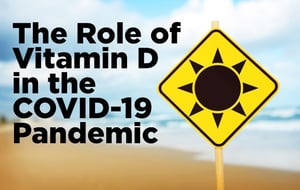Growing evidence shows proper vitamin D levels help fight severity of illness, mortality rates.
When global scientists and researchers began sequencing the complete genome of SARS-CoV-2, the virus that causes COVID-19, they were racing to find treatment solutions for the novel coronavirus. Potential treatments were being investigated daily, including research of common vitamin sufficiency. Vitamin C  and Zinc have long been known to boost immune system health, which could help against this respiratory illness. But how big could vitamin D’s role be in combating the effects of COVID-19?
and Zinc have long been known to boost immune system health, which could help against this respiratory illness. But how big could vitamin D’s role be in combating the effects of COVID-19?
Somewhat surprisingly, researchers have discovered a strong correlation between severe vitamin D deficiency and mortality rates in COVID-19. Hospitals and clinics in China, France, Germany, Italy, Iran, South Korea, Spain, Switzerland, the United Kingdom and the United States have noted patients with lower levels of vitamin D had higher mortality rates than patients who were not deficient in vitamin D.
Unexplained differences in COVID-19 mortality rates from country to country originally led researchers to examine vitamin D levels and cytokine storm – a hyperinflammatory condition caused by an overactive immune system – and a correlation between vitamin D deficiency and mortality. For example, patients from Italy, Spain and the United Kingdom had lower levels of vitamin D compared to patients in other countries, and they also had higher mortality rates. Patients in Norway, Finland and Sweden had higher vitamin D levels despite less sunlight exposure than Italy and Spain because supplementation and fortification of foods is more common in these Nordic countries.
The correlation between low vitamin D levels, cytokine storm and death from COVID-19 is statistically significant. Cytokine storm can severely damage lungs and lead to acute respiratory distress syndrome, and this is what seems to be the cause of most COVID-19 related deaths. However, vitamin D enhances the immune system and helps prevent the immune system from becoming dangerously overactive. It won’t prevent a patient from contracting COVID-19, but according to some recent studies, it might cut the mortality rate of COVID-19 in half and reduce complications.
Researchers note that vitamin D deficiency is more prevalent in African American patients and elderly patients – two populations that have been most affected by COVID-19.
How many people are vitamin D deficient?
Vitamin D deficiency is very common as an estimated 1 billion people worldwide have low levels of vitamin D in their blood. About 42% of adults in the United States are deficient, and this percentage jumps to 69% in Hispanics and 82% in African Americans. Exposure to sunlight each day helps the human body to manufacture the required amount of vitamin D, but most people avoid sun exposure due to the fear of developing skin cancer. To prevent vitamin D deficiency, one should spend 15 to 20 minutes daily in the sunlight with 40% of the skin surface exposed.
High concentration of melanin in the skin slows the production of vitamin D and aging greatly reduces skin production of vitamin D. The amount of vitamin D your skin makes also depends on the time of day, season and latitude. It may decrease or be completely absent during winter months, depending upon lifestyle.
Vitamin D supplementation
To make it even more challenging, vitamin D isn’t found in many foods. However, it can be found in fortified milk, fortified cereal and fatty fish like salmon, mackerel and sardines. The recommended daily amount of vitamin D is 400 international units (IU) for children up to 12 months, 600 IU for ages 1 to 70, and 800 IU for ages over 70 years. Taking a multivitamin with vitamin D will likely help older adults who don’t get regular exposure to sunlight, have trouble absorbing vitamin D and are at higher risk for developing osteoporosis. Vitamin D is generally considered safe when taken in appropriate doses.



Share Article